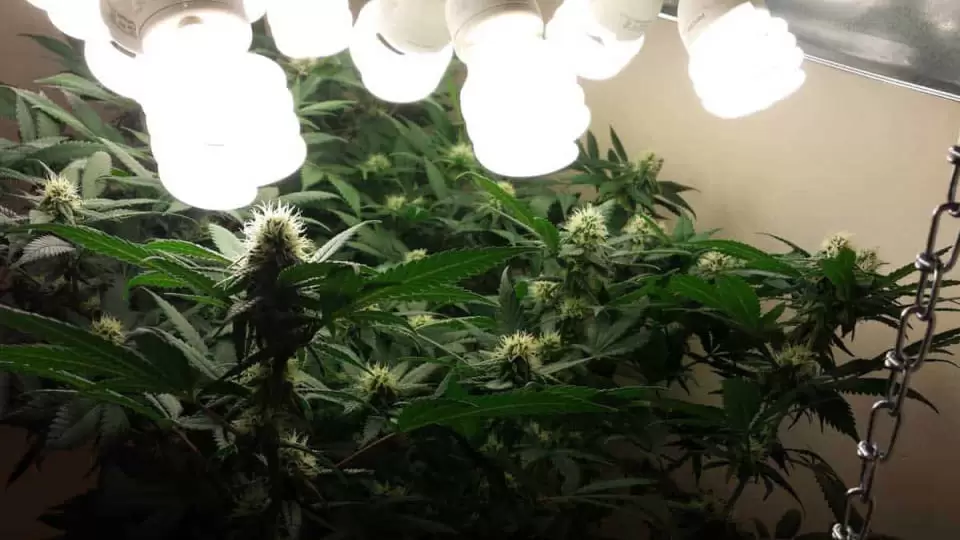Z

70% Indica
Compact Buds Coated in Sugar
Mouthwatering Fruit Candy
Powerful Nighttime High
Soothing Stress Relief

Balancing the light cycle for the flowering stage in indoor plants is a complex yet essential process. Both the quality and the chemical composition of your plants are affected by the light you provide them.
Now, the light you need to provide for the plant will depend on its type. The photoperiod plants will need more precise control, while the autoflower can work with various light conditions. So let’s have a look at both of them separately.
Light is more than just a source of energy for cannabis plants; it’s a trigger and sustainer for crucial biological processes, especially during the flowering stage. At the heart of this is photosynthesis, where plants convert light into energy. This energy is vital for the synthesis of essential molecules and the production of flowers.
During the flowering phase, cannabis plants produce specific photopigments that are sensitive to changes in the light-dark cycle. These photopigments play a role in determining when the plant will flower based on the light they receive. Additionally, the type and quality of light influence the production of cannabinoids and terpenes, compounds responsible for the plant’s medicinal and aromatic properties. In essence, light not only fuels the growth of the plant but also orchestrates the chemical symphony that results in rich, potent cannabis buds.
Photoperiod cannabis plants require varying light amounts based on their growth stage. During the vegetative phase, they need ample light for photosynthesis and nutrient absorption.

However, as the plant matures and enters the flowering stage, a consistent light schedule becomes crucial. Typically, the plant requires a 12-hour light and 12-hour dark cycle to yield healthy buds.
While it’s possible to lessen the light duration, it’s not advisable. Altering the 12-hour light cycle can impact the plant’s health and the quality of the cannabis buds. Insufficient light—less than 12 hours—can hinder photosynthesis and nutrient processing, leading to decreased yields.
Autoflowering plants, due to their genetic makeup, don’t rely on light cycles to transition between growth stages. Their primary need for light is for photosynthesis, offering growers flexibility in choosing light schedules. Here are some popular light cycles for autoflowering plants during their flowering stage.
| Light Schedule | Description | Recommendation |
| 18/6 | 18 hours light, 6 hours rest | Best Choice |
| 24/0 | Continuous light | Rapid growth, risk of stress |
| 20/4 | 20 hours light, 4 hours rest | Balanced growth |
| 12/12 | Equal light and rest | Budget-friendly |
| 6/2 | 6 hours light, 2 hours rest (repeated) | Experimental |
A widely preferred cycle, this involves 18 hours of light and 6 hours of rest. It’s a balanced approach, catering to the plant’s light needs while ensuring adequate rest.
A belief among some growers is that more light equals faster growth. While not heavily backed by science, some attest to the benefits of continuous light exposure throughout the growth and flowering stages.
A middle ground between the 18/6 and 24/0 cycles. Plants receive 20 hours of light and 4 hours of rest, either continuously or broken into segments. This schedule aims to boost growth rates without risking light overexposure.
12/12 Light Schedule
A cost-effective approach, providing 12 hours of light and 12 hours of darkness. While it ensures reduced electricity consumption and adequate rest for the plants, the growth potential might be limited, especially for certain strains.
Some growers believe in breaking up the light and rest periods. Instead of 18 continuous hours of light, the plant gets 6 hours of light followed by 2 hours of rest, repeated three times. The idea is that well-rested plants absorb light more efficiently.
Cannabis cultivation, especially with photoperiod strains, is an intricate dance heavily influenced by precise lighting. These plants are finely tuned to their light environment, and even the smallest deviations in their light schedule can have significant impacts, potentially compromising the quality or even the entirety of your yield. As a cultivator, it’s paramount to thoroughly understand and respect the various light cycles during the flowering stage. It’s worthwhile to experiment with different cycles initially, gauging which one resonates best with your plants and cultivation environment. And while adhering to recommended light schedules is essential, there’s room for adaptability. Feel free to fine-tune and adjust based on your observations and the plants’ responses, always ensuring they receive the vital light they need to flourish.

Are you 21 or older?
You must verify that you are 21 years or older to enter this website. By proceeding, you are also agreeing to our terms and conditions, as well as consenting to the use of cookies on this site.